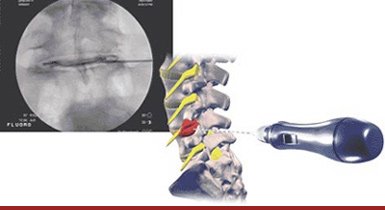Spinal Cord Injury Lawyers discusses Percutaneous Discectomy as minimally invasive medical option for traumatic back pain

Millions of Americans suffer from chronic, persistent back pain. Many of these find relieve for their condition in the form of procedure known as percutaneous discectomy for herniated disc.
A common cause of chronic back pain is a bulging or distended disk in the spinal column, also known as disc herniation or more commonly as a herniated disc. The distended disk can press on a nerve, causing moderate to severe pain and limited mobility.
The spinal column is made up of a series of bones, called vertebrae. Between each vertebra is a spongy disc which serves as a sort of shock absorber between adjacent vertebrae. The disc also acts as ligaments and plays a major role in providing flexibility and freedom of movement of the back.
The disc consist of an inner layer, known as the nucleus pulposus, and an outer layer, known as the annular fibrosis. When the outer layer begins to deteriorate or is damaged, the inner layer will bulge outward, much like a weak spot on a tire. This bulge can impinge or press on adjacent nerves and cause a number of unpleasant symptoms ranging from mild discomfort to debilitating, chronic pain.
Treatment for this condition ranges from opiate pain management to relieve the paint to traditional invasive surgery to relieve the pressure on the involved nerves.
Percutanous discectomy provides a treatment option that is minimally invasive.
The process is fairly simple. First, the patient is given a sedative to help them relax. Next, they are placed on a treatment table and given an injection or series of injections of local anesthesia in the area of the back that is to be treated. In some cases, the patient may be given a general anesthetic
Once the patient is immobilized, the physician will insert a large needle or probe into the problem area. Using a fluoroscope, which provides real-time images akin to x-rays, the physician will carefully guide the needle or probe to the affected disc. Once it is properly positioned, the physician will use heat or radio waves to reduce the size of the disc and release the pressure of the disc on surrounding nerves.
The procedure takes about 30 minutes and can be performed on an outpatient basis, meaning the patient will be released to recover at home in between one and three hours after the procedure has been completed. The patient may experience pain and tenderness in the affected area for 24 to 48 hours after the procedure.
Within a few days, the patient should experience considerable relief from pain and increased mobility. The patient’s physician will advise them on how long they will need to allow for recovery from the procedure before resuming their regular activities.
For most patients, percutaneous discectomy can provide a very effective treatment for back pain without the need for far more invasive surgical interventions.
Contact us for more information on possible treatments for your back injury.



